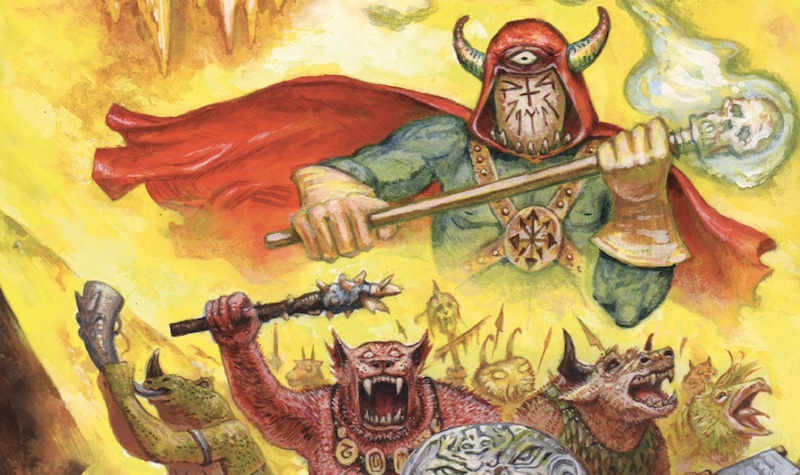
Dungeon Crawl Classics funnel - Review
Goodman Games’ 2012 gonzo dungeon crawler stays true to many stated principles of 1970’s role-playing games. However, in a move they introduce as purposely anachronistic, the Dungeon Crawl Classics “Character Creation Funnel” makes for an interesting introduction to the game and system.
Spoilers: for module Sailors on the Starless Sea
Site: https://goodman-games.com/dungeon-crawl-classics-rpg/
Purchase:
- Core book: Physical and PDF
- Sailors on the starless sea : Physical and PDF
Community: Discord
Pages: 600 (chonker core book), 18 (Sailors)
Release: 2012
Roll20: Free Character Sheet, paid modules
FoundryVTT: Free System support, paid modules
My Familiarity: Played 1 funnel, read the full core book
What this game is about
Reviewer’s note: Games need to know what they are about. The market is crowded and few games have the luxury of being middle of the road. What is the appeal of a game to the players, including the game master?
Dungeon Crawl Classics (DCC) is advertised as “This isn’t your father’s D&D…it’s your batshit crazy uncles’ D&D,” and that may be true beyond 0th level when classes, spellcasting, corruption, and other randomized mechanics kick in. This review is of the Funnel, where each player controls multiple peasants moving through a murder dungeon better suited to 1st or 2nd-level adventurers.
This experience is about D&D players shedding acquired habits from more modern editions of D&D and returning to an older aesthetic of RPGs and maybe an older style of play. This game is about the weird, odd, and now glamorized world of the 1970’s D&D table seen from the perspective of a 2012 community tired of World of Warcraft and D&D 3.5’s influence on the hobby. This game is about interacting with the world and letting the dice decide the consequences.
Why run a Funnel?
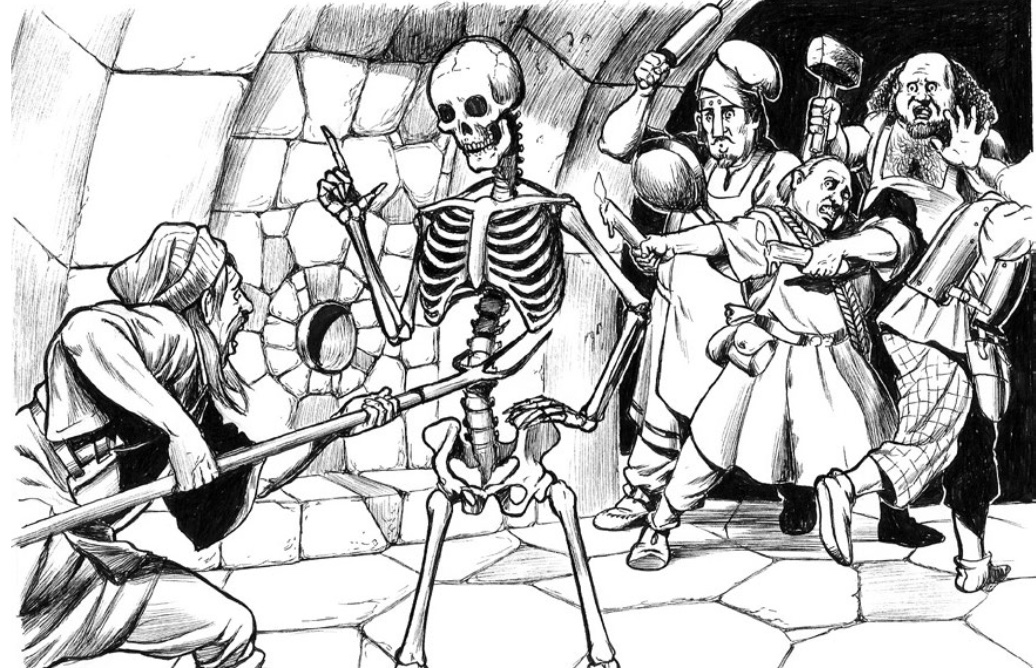
lessons must be learned
The funnel pits the players and their ingenuity in controlling two to four peasants against a formidable dungeon of monsters, puzzles, and challenges. Unlike most mainstream role-playing games, the funnel as written in the DCC core book demands following the exact procedure of having players generate their characters entirely randomly. For a convention or one shot, most judges (as GMs are called in DCC) use the Purple Sorceror 0-Level Party generator to save time, though I suspect with more time players would appreciate rolling 3d6 in order, as Crom intended.
This removes the ‘build’ aspect of character creation and makes the players understand that the characters are somewhat disposable at the start. What makes them valuable and worth remembering is what they do in the game. As stated in the start of the core book.
This is the story of how the adventuring party was formed. They are the survivors of a peasant raid into a dungeon that tested their wits, will, and courage. It establishes an in-game story for a shared experience they all have and seeks to connect the players emotionally to the at most fifteen short lines of text that make up a 0-level character.
Easy to grok rules
For those who have played any edition of D&D or Pathfinder, DCC is going to come naturally. Technically a clone of the 3e era d20 system, DCC is built on the scaling fundamentals of original D&D. The rules my players needed to interact with the world fit in a quick two to three-page cheat sheet:
Azathought’s Zero level Dungeon Crawl Classics Cheat Sheet
Confusing rules
DCC relies on the judge already being an experienced RPG player, and states as much in the core book. This might not be a good system for those that aren’t comfortable making rulings at the table or need a rules-as-written level of specificity in the mechanics. It is rules light, but there are a handful of harder-to-explain rules that gave me trouble.
- Burning luck is a hard one for players to understand as they don’t understand the consequences of using it, how hard it is to get back, or what they need their luck for. I found players didn’t make use of this.
- Can halflings wield great-axes? I couldn’t find anything in the book after the game.
- What dice do monsters roll on the monster critical hit table that is on the inside of the Judges screen?
Other somewhat complex rules like critical hit ranges and two-weapon fighting have been clarified and expanded in more recent printings of the core book.
A chonker, A complete game
A refreshing surprise to reading this large core book is the realization that the game is self-contained. There are no expansions or class feature splat books, just adventure modules. This is unusual in today’s publishing world where as soon as a book Kickstarter is delivered we begin to learn about the next expansion book which will make it more playable.
The book is 600 pages long not because the system is high crunch, but because it is packed with full-page art and each spell comes with a random table of outcomes. Almost all magic is wild-magic. So the book is beefy, but it’s the only core book to buy for the system, which will be appealing to some.
Sailors on the Starless Sea
Spend any time in the online communities around DCC and you’ll get recommended Harley Stroh’s module, Sailors on the Starless Sea (sailors) as the go-to first funnel module. I started here. It’s a good fast read. It combines high stakes, epic locale, and a grim-dark ambiance that players may not be used to after decades of being asked to fight goblins and kobolds and sit through a few weeks of world-building before advancing to an adventure that feels like an adventure.
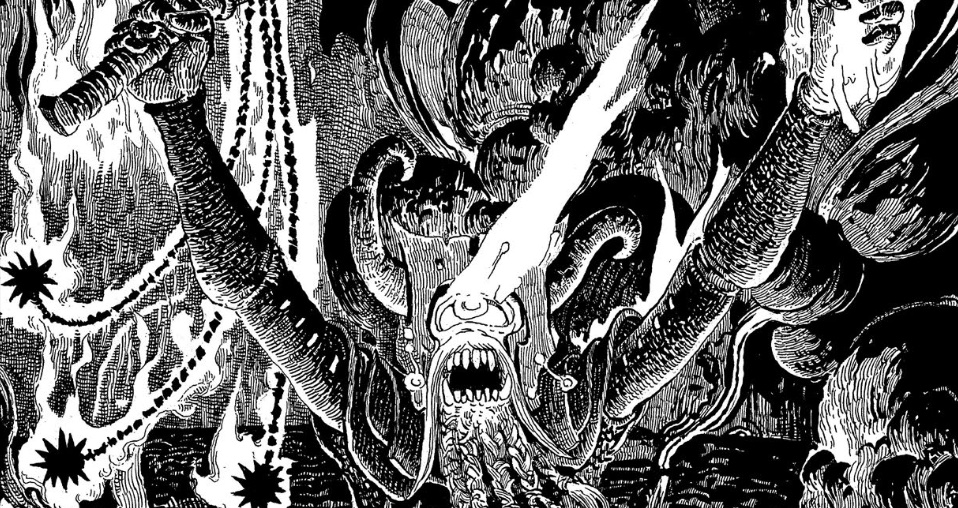
It's a solid module. The art is also excellent
My players enjoyed the adventure. As a judge, I liked how the first part of the adventure was wide open allowing players to choose different approaches before narrowing the path to a more linear convention and one-shot-friendly conclusion.
I am an experienced GM. I know when to ask my players to role dice, I’ve run full mystery campaigns and I know when to hide clues. I noticed that my players, who are coming directly from 5e, were not describing their actions, and I was relying heavily on the boxed text to set up the rooms and my drawn maps to guide their exploration. As a note to myself, if were to run another old-school game I’ll need to remind myself to ask the players to describe how they are going about all exploration actions.
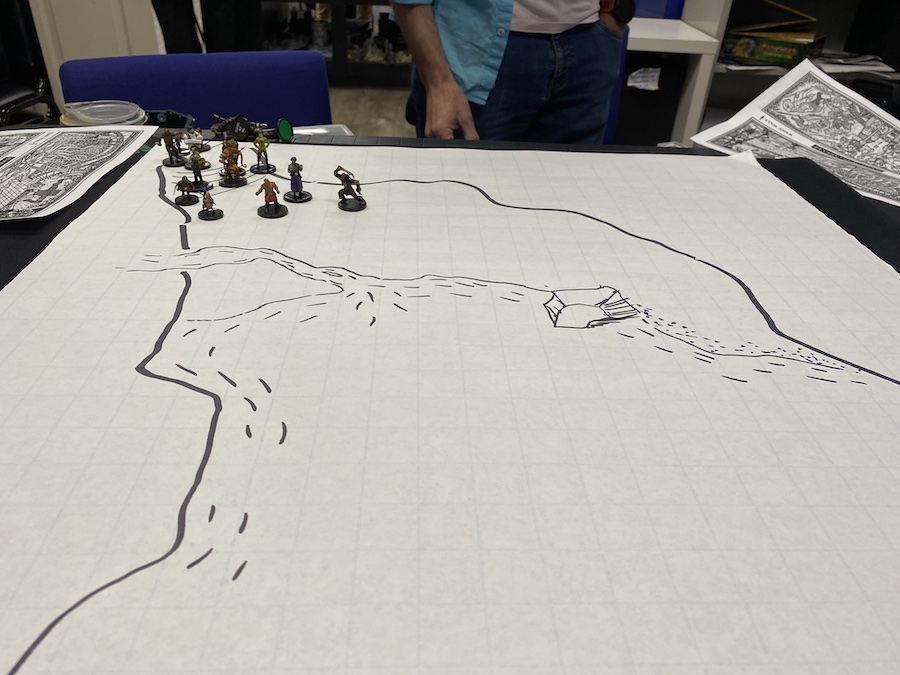
13/16 remaining characters reach the lower level
Out of what I have to assume was subconscious meta-story reverse engineering, one of my players immediately guessed a workable solution to the “starless sea” puzzle, which I won’t spoil here. They enjoyed it, which is all that matters.
I’ve now read or skimmed levels 1 through 5 Harley Stroh “adventure path.” Quotes because there isn’t any meaningful connection between these adventures. 0th-level Sailors and the 1st-level adventure Doom of the Savage Kings are worth it. I wasn’t drawn to the others.
This is you can’t go wrong territory, not life-changing territory. If all you’ve played is 5e books, this is likely a great intro to a short and sweet high theatric dungeon crawl.
Is it OSR?
Not all D&D alternatives are part of the Old School Renaissance. Neither are all Old School games. DCC’s mechanics wind back the clock on many parts of 3e mechanics so that the game feels and plays more like 1e. It subscribes to many of the tenants of OSR play style like being an Impartial Arbiter, getting the players thinking, letting the dice kill the players, and that power is earned and heroism is proven.
Even if it doesn’t have some of the more modern streamlining of rules descriptions of more recent OSR games, DCC is squarely OSR and will help games to be run in that style. I suspect that the weird factor that gets introduced into the game once character classes are introduced at 1st level may distract players from the this-is-OSR-ness or presentation, which may be a good thing.
Mortality
In my funnel of 4 players wielding 16 total characters, 50% of the characters died, oddly all the halflings survived and I think it’s only because I made choices not to attack them but rather to have the cultists try to sacrifice them in the final fight of the adventure.
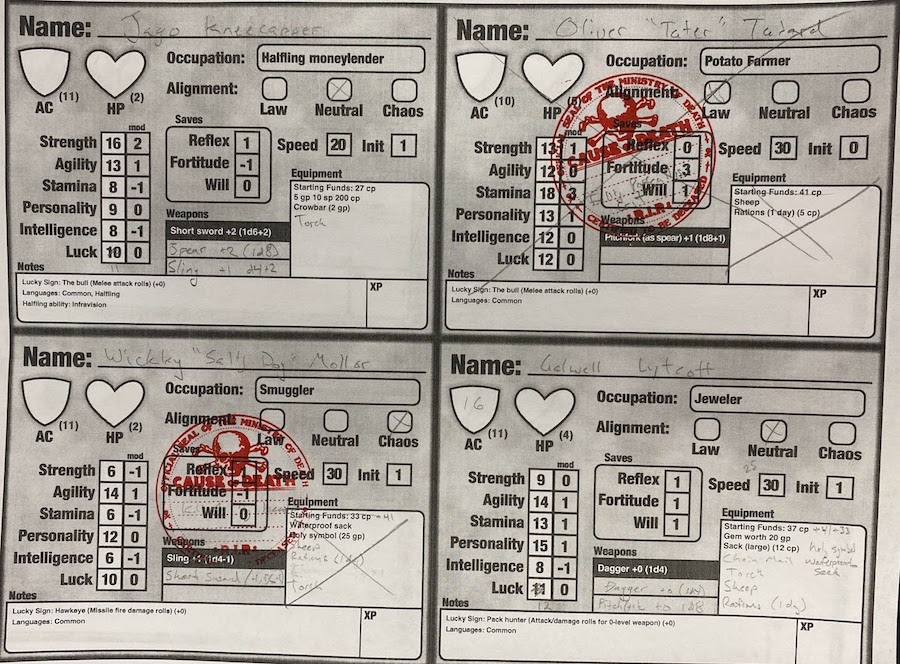
Not everyone made it, they were not expected to
Only a few players were tough enough to survive a hit inflicting damage, none were tough enough to survive a second hit. I may have chuckled a bit too merrily when one player asked if they regained hit points when resting.
Last advice: buy a Character Death Stamp
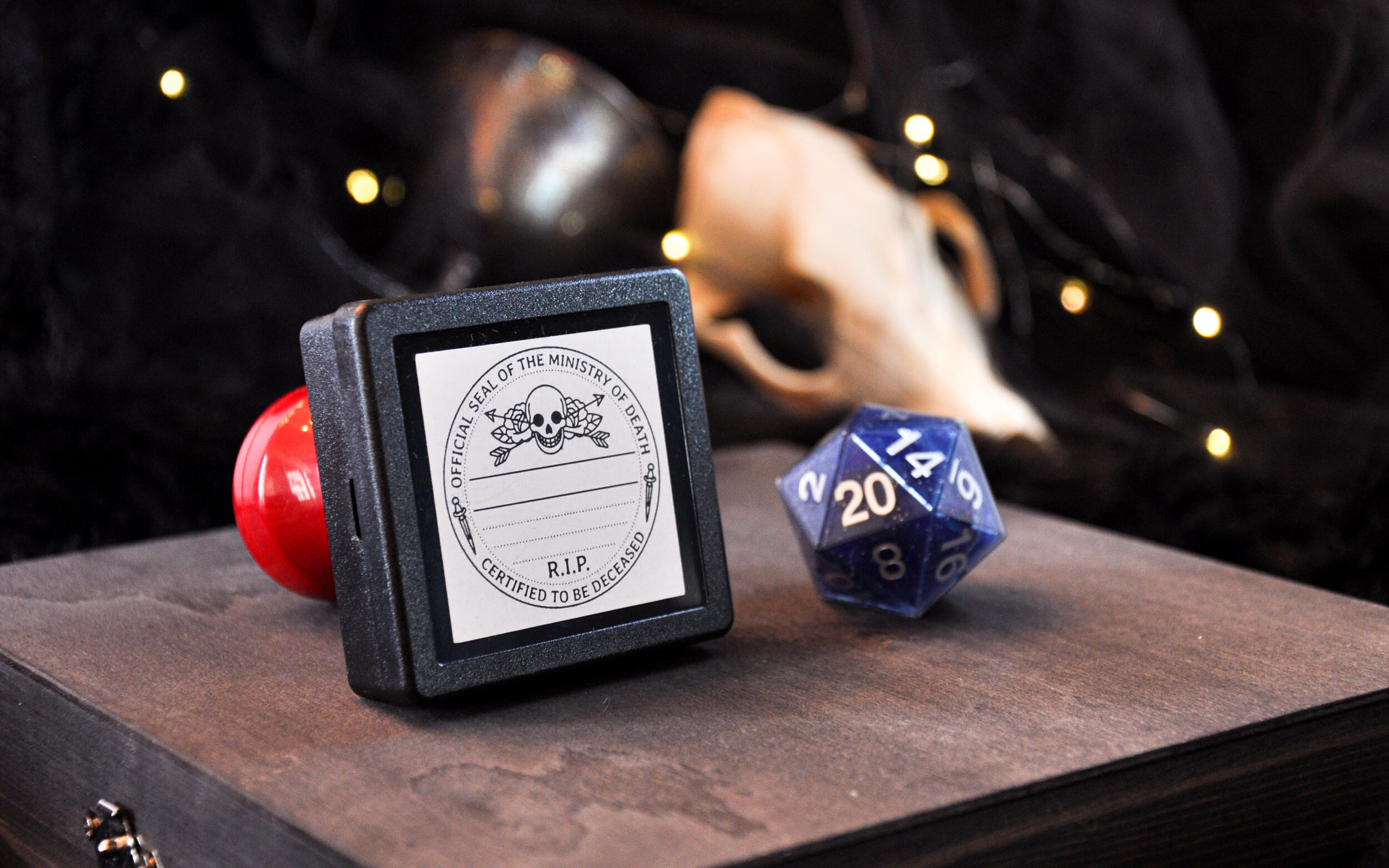
I loved the experience of stamping PCs as dead forever. Probably less fun for characters beyond 0th level
I bought this one. Let players know death is permanent.
https://weird.works/peculiar-products/official-cause-of-death
Ecosystem Support
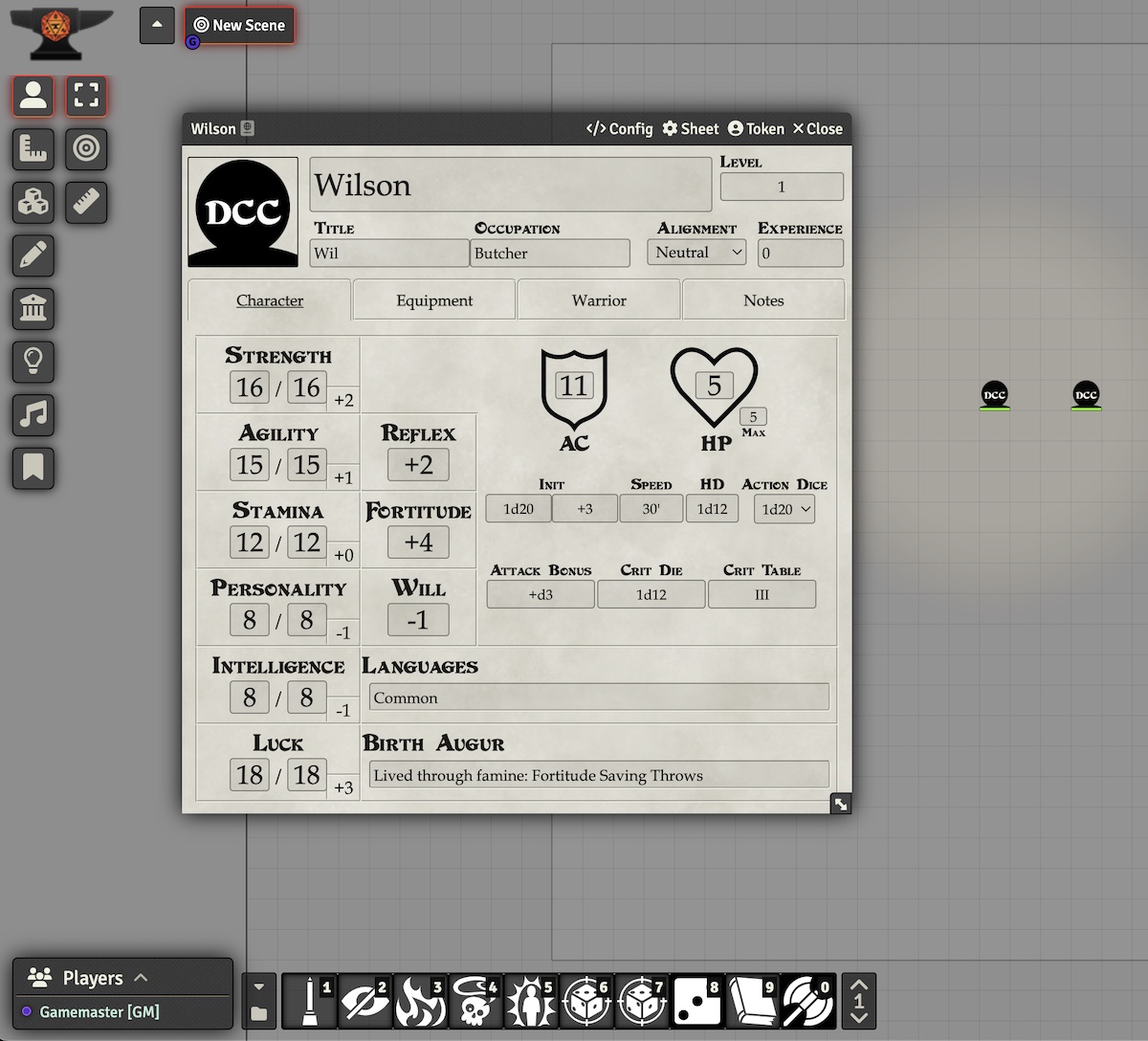
It's a basic character sheet
The Roll20 and Foundry VTT support is what I would describe as 2nd tier quality. The game mechanics are not fully modeled and the adventures I checked out don’t come with fully gridded playable maps.
However, there is a large community making digital tools for the game. Purple Sorceror Games has a wide array of web-based tools and I suspect there are plenty of VTT groups that do most of their rolling and table referencing here.
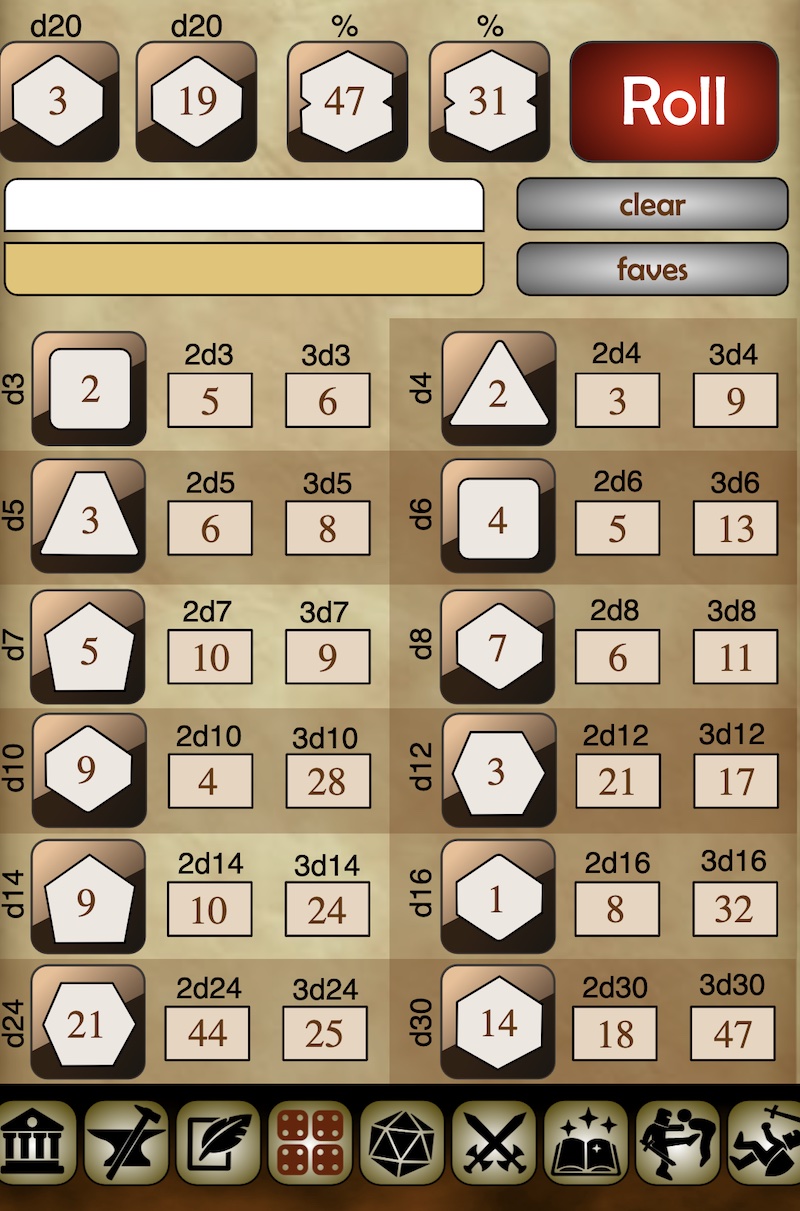
Paper and pen may be all you need for online DCC play, but a good online roller and random table roller can speed things up.
Read, Play, or Skip
This game is a must-play, but I’m wondering if I should have waited for when I had time for a three-shot to make sure my players would get to experience DCC fully with the wackiness of class levels.